Stories
Lindsay Kennett
1928-2016
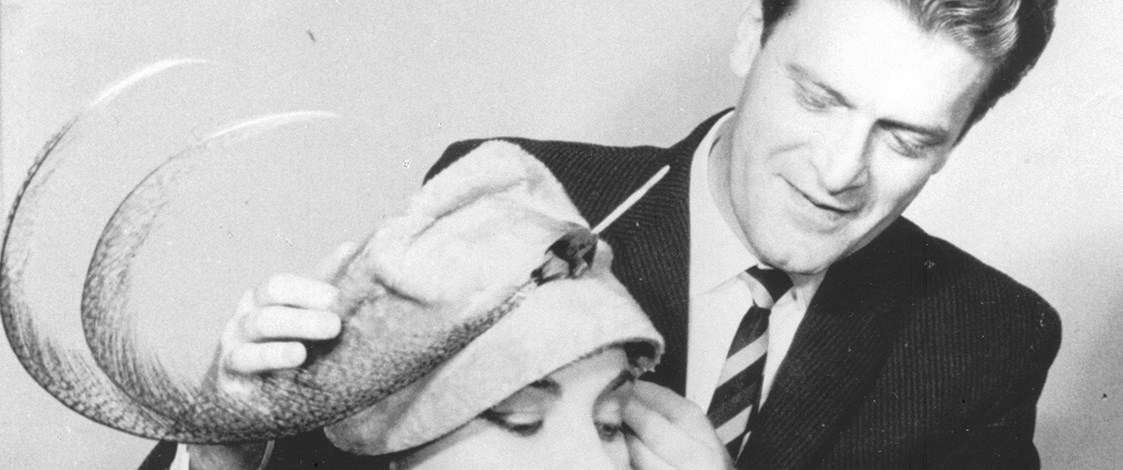
By the 1930s, there were hundreds of milliners in New Zealand. "Hats were an everyday fashion item, like gloves and matching handbags," says Lindsay Kennett who started his own wholesale millinery business in Auckland in 1952, aged 24. "90 percent of women wore hats because that’s what etiquette decreed. People today don’t realise how enormous the hat trade was. Even the tiniest little town had its own hat shop. The main centres had several."
There were two places women went to buy their hats – millinery salons, with fancy names like Chapeaux Suzette, and department stores. The salons, run by individual milliners, carried a small selection of exclusive hats and also made to order. Rumour has it that salon clients were often appraised as to their affluence and charged accordingly. Hats in the major department stores were designed and made in the stores’ own millinery workrooms, imported from Paris or London or sourced from independent milliners or one of the many hat factories operating at the time. Ross & Glendining was one of the biggest," recalled Lindsay. "Others that come to mind are Warner Hats in Dunedin and Vogue Millinery, Gainsborough Millinery, MK Hats and Plummer Hats in Auckland." Plummer Hats had a licence to reproduce the ready-to-wear designs of Aage Thaarup, the Queen Mother’s milliner, who was based in London.
Hat Protocol
In department stores, vast areas were designated for the display and sale of model hats, which were treated with great reverence. "You didn’t just go marching in and try a hat on," says Lindsay. "An assistant would retrieve the hat of your choice from its stand or glass case and carefully place it on your head at the right angle."
A number of stores also had do-it-yourself Hat Bars, located well away from the posh millinery departments, where customers could choose a shape, fabric and trim and complete the hat at home. Lindsay bought his first wooden hat block from the Hat Bar at James Smith’s in Wellington.
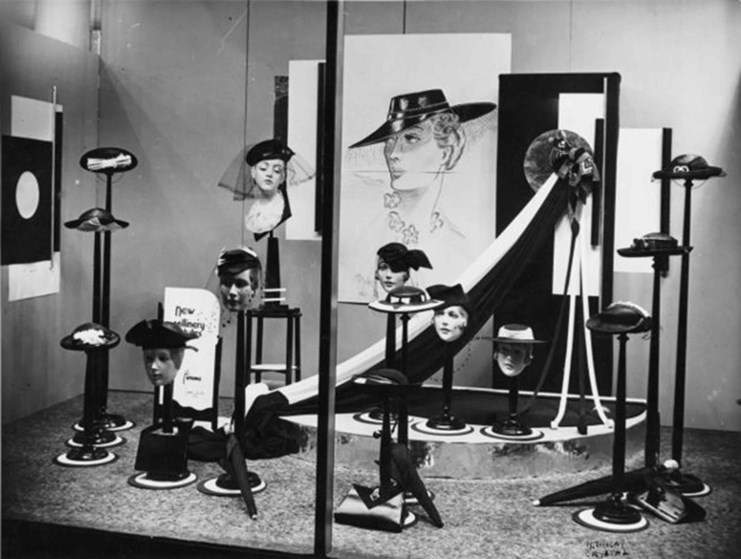
Window display of women’s hats, James Smith’s department store, Wellington, circa 1940s. Photo courtesy of Alexander Turnbull Library, PAColl-3332-03-37.
A Wellington woman who worked as a millinery trimmer on the James Smith’s Hat Bar says she was employed to advise customers on the trim, feathers and other decorations they wished to use on their hats. "In the era of DIY, trimming one’s own hat was a popular option for those who couldn’t afford the more expensive hats in the millinery salon. Many of the women would bring their hats back into the store to show me their efforts."
It was while he was dressing the hat windows at Kirkcaldie & Stains in Wellington in 1950 that Lindsay Kennett decided to become a milliner. "The hat buyer, Miss O’Donnell , liked the experimental hats I made and asked me to do some for the store. They were small felts in bright colours. White felt hats were also hugely popular at this time. If hats weren’t selling and you put in a window of white felts, they’d sell out in no time."

Wooden hat black purchased by Lindsay Kennett in the 1950s. All Rights Reserved, Image © Kennett Archives.
In 1950s’ New Zealand, designing and making model hats for women wasn’t considered a masculine occupation. Lindsay says he could count the number of his male counterparts on one hand. "Independent milliners were mostly women and, in Auckland, a lot of them were émigrés from Central Europe. Hat factories employed men, but as machinists, not to do the finer work." One of Lindsay’s few male contemporaries, Philip Somerville, whose family owned a wholesale millinery business in Invercargill, moved to London in the 1960s where he eventually became a milliner to the Queen. He designed hats for Princess Diana, and the Duchess of Cambridge is now a client.
Lindsay’s comments on the relegation of gender roles within the hat trade are confirmed by a Wellington milliner who recalls the recruitment of girls into the industry. "There was a Government vocational guidance department that firms would often approach when wanting to make contact with schools. As a result of a visit to my school by Gregory Hats, I went on a trip to their factory. The men were blocking the hats and the women were constructing them."
On The Road
For almost 40 years, Lindsay Kennett was one of the main wholesalers of model hats to major department stores around the country and he also supplied fashion stores in smaller towns. In his Auckland workroom, sometimes with help but usually single-handedly, he produced two seasonal collections per store per year. Every design was different. Part of the deal with some of the bigger stores, such as Beath’s in Christchurch and C. Smith’s (later Farmers) in Wellington, was that Lindsay front up in person and present each new collection to the public. He did this for 16 years, until the demand for hats declined, travelling with his hat blocks and often ending up putting the finishing touches to his creations in his hotel room.
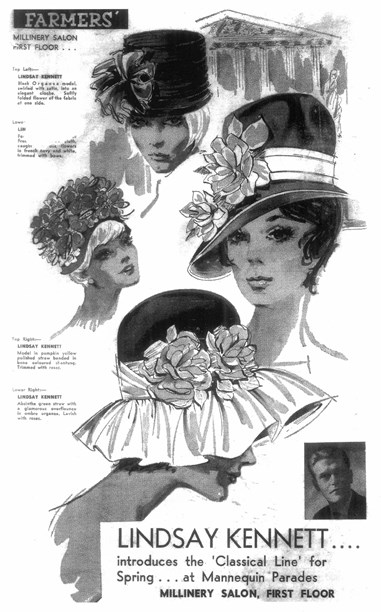
This Farmers’ advertisement for a Lindsay Kennett in-store visit and parade in 1960 appeared in Wellington’s Evening Post. All Rights Reserved, Image © Kennett Archives.
In 1962, Lindsay opened a millinery salon in affluent Parnell, which he operated in tandem with his wholesale business. After five years, he shut up shop. "Making bespoke hats for women of means was an enjoyable experience," he says. But my workload became unmanageable. The salon had to go."
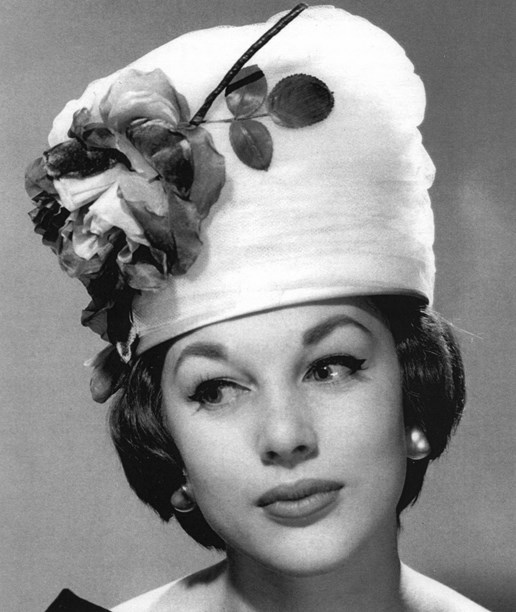
Fabric-swathed toque with flower trim made by Lindsay Kennett for Milne & Choyce, Auckland in 1963. All Rights Reserved, Image © Kennett Archives.
Up With The Play
As was the custom in fashion then, milliners followed overseas trends, taking their cue from magazines like British Millinery and Chapeaux, a French publication. The British Colour Council released colour forecasts ahead of season and this enabled Lindsay, and other milliners who supplied department stores, to anticipate which colours were the most likely to be promoted. Ming blue, one season, fiesta pink, off-white or burnt orange, the next.
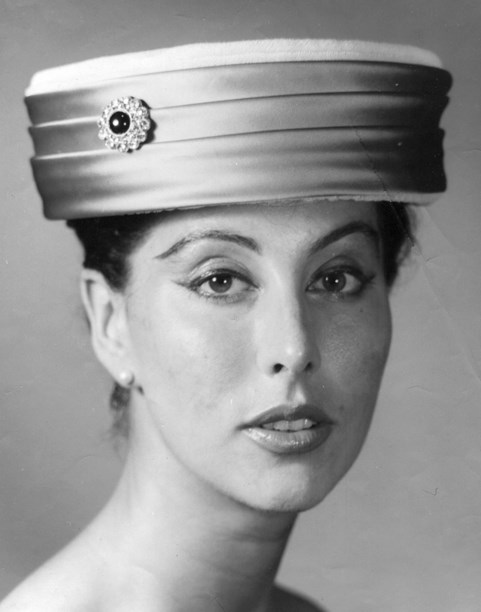
Lindsay Kennett cream velvet and burnt orange satin ‘cake-tin’ hat modelled by Robyn Garland, 1957. All Rights Reserved, Image © Kennett Archives.
The hat trade had a vocabulary of its own. Crinoline straw. Hatter’s plush. Peachbloom. Melusine (a long-haired felt). Beaver (a felt with a teddy bear-like texture). These and other materials used in hat manufacture and decoration were imported mainly from France, Italy, Switzerland and the UK by large companies such as Ross & Glendining and Abbot, Armstrong & Howie, and also by smaller importers. When fur hats became fashionable, at the end of the 1960s, local furriers provided Lindsay Kennett with the mink, silver fox and Persian lamb he needed for his berets, pillboxes and toques.
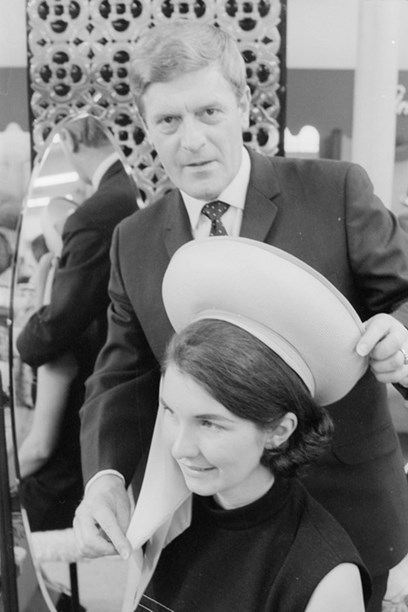
Lindsay Kennett adjusts a straw Breton worn by a model in a Wellington store parade, 1971. Image courtesy of Alexander Turnbull Library, EP/1971/3586/9-F.
Hat Versus Hair
The hat’s slow demise began in the 1960s with the deformalisation of dress, the growing influence of young fashion designers and the advent of 'big' hair. As hat sales decreased, department store millinery departments became smaller and smaller, disappearing altogether in the 1990s. Hat shops and hat factories closed down. The New Zealand hat trade, which had provided a livelihood for so many people for so many years, was reduced to just a few independent milliners.
"There were still some stalwart hat wearers," recalls Lindsay Kennett. "Fortunately for me, they were catered for by department stores such as Smith & Caughey’s, Ballantynes and Kirkcaldie & Stains, establishments with whom I had enjoyed a long association. Although they stocked only a small selection of hats, I received enough orders to keep my business going."
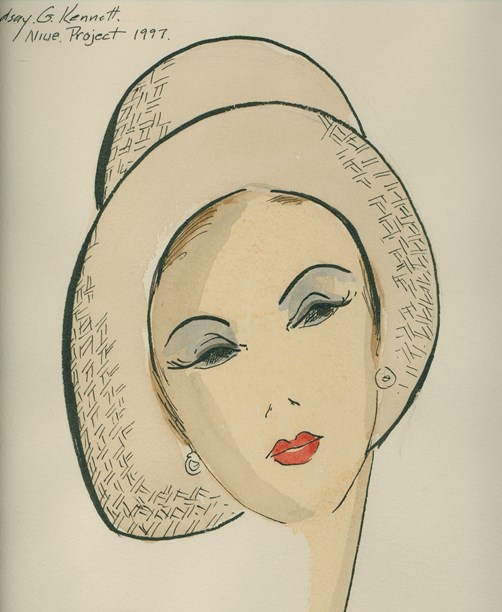
Lindsay Kennett sketch for 1920s-style straw cloche, 1990s. All Rights Reserved, Image © Kennett Archives.
Lindsay Kennett retired from business in the early 1990s and moved to Dunedin where he continued to make hats, reproductions of styles from earlier eras, for exhibitions and charity hat shows within the southern region.
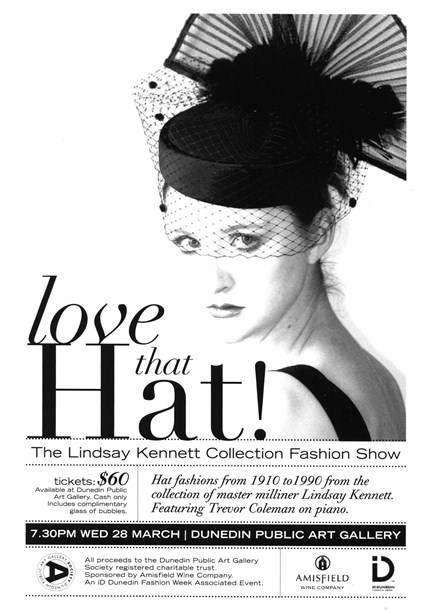
Flyer for ‘Love That Hat!’ exhibition, Dunedin Public Art Gallery, 2013. Photo by Quentin Furlong.
Footnote: Lindsay Kennett passed away in 2016. His family donated a large collection of his southern exhibition hats to the Toitū Otago Settlers Museum. Examples of his earlier work can be found in the New Zealand Fashion Museum online collection.
Text by Cecilie Geary. Banner image © Kennett Archives.
Last published April 2014.